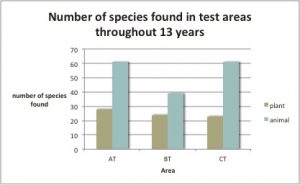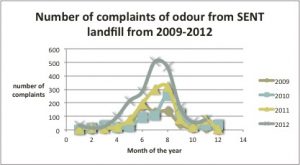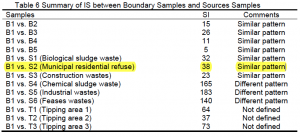To assess the Hong Kong’s waste management system, I will investigate the ecological performance and social impact of various landfills.
Ecological performance
A study focusing on the ecological performance of SENT landfill shows the soil’s quality has deteriorated and the area might not be ecologically self-sustaining if it is not monitored. Since the construction of the landfill in 1994, the Hong Kong government initiated a revegetation program to revitalize the area. A study conducted in the span of 13 years comparing the ecological performance in 3 different areas around the landfill showed us that the area closest to the landfill has very different plant species than the other two areas.

A decrease in soil moisture content, total organic content, organic matter and soil pH created by the landfill made it difficult for native species to grow. Instead, pioneering species are dominating the area, which results in a low biodiversity. This shows that effort for restoring the areas around the landfill through revegetation has failed because the ecosystem might not be self-sustaining (1671). On the bright side, the study shows that the landfill cover and gas collection system was effective in reducing air pollutants such as CH4 to lower than 0.01%. The number of species found in AT throughout 13 years is similar to number of species found in CT, which means the man made effort was not wasted. With that said, it’s uncertain how the landfill would affect the environment once it is filled up. Infrastructures built to prevent pollutant from affecting the surrounding areas might deteriorate slowly over time.

Odour pollution
Other than that, there have been complaints the SENT landfill and transport trucks are emitting odour that affects nearby neighbourhood, Tseung Kwan O. The graph below shows the number of complaints from the SENT landfill has been increasing steadily since 2009 to 2012. A study focusing on the impact of odour on surrounding communities shows the odour detected in the neighbourhood is similar to odour at the boundary of the landfill (Ll, 84).


From both ecological and social standpoint, the SENT landfill had a negative impact on both fronts. Although the government makes an effort to recover ecological balance through revegetation program, the assessment shows the environment around the landfill might not be able to recover to its former habitat. Further on in this report, I will discuss the government’s response towards the odour problem in Tsueng Kwan O area.
Water Contamination

Other than the SENT landfill, the NENT landfill has been accused of polluting the nearby communities as well. Several villagers living in Ta Kwu Ling area are blaming the NENT landfill for polluting the local Ping Yuen river. Many residents in the area depend on the stream’s water source for agriculture. These villagers are afraid to use the water for agriculture because they don’t know if that will affect their health. Local resident Lau Tsan-hung believes the pollution came from the trucks transporting waste in and out of landfills. These trucks would often leave behind sewage water, which he claims will flow into the Ping Yuen river. He also expressed that he has lived in the area since he was a child, and the water quality has only worsened since the landfill was built in 1995. “Now, we don’t dare let our children play in it.”, expressing his concern of the water quality, which he described as “black and muddy”. Moreover, another resident Lam Yuet-foon complained the stream would often give off a “foul smell”. On the other hand, principal environmental protection officer Lawrence Lau insists their department regulate the water standards monthly. So far, the water quality is up to standard. In this account of pollution, it remains unclear whether the pollution really came from the landfill trucks. However, it raises question on whether the government are taking appropriate measures in taking care of the environment and communities around these waste treatment facilities.
Insanitary refuse collection point
From my personal experience, waste collection points are not very sanitary. At both the Sai Kung and Mong Kok location, they are placed right next to high traffic bus terminals. There is constantly an odour around the area and wastewater pouring out from the collection point. There would often be pests looming around the area as well. It can become an obstruction for passerby and nuisance for the community, which gives waste management a bad image. If people weren’t upset with the government to begin with, the collection point could easily irritate them and making the general public resent waste management.


Shoreline pollution
The Hong Kong government is not the only institution responsible for pollution of waste. In the past year, trash has been washing onto shoreline all over the city. On November 5, The Food and Environmental Hygiene Department collected 1500kg of trash in total (Marsh). July 1 to 9 alone, Hong Kong government departments collected 78000kg of garbage from the shoreline (Kao). When I spent my summer in Hong Kong visiting beaches, I witnessed the pollution firsthand. I was on a boat trip to an island just outside of the city. However, my anticipation of a nice day out on the beach were instantly destroyed by a horrific sight. I was offended and disappointed to see the trash-covered shoreline. Kao’s article perfectly describes the condition of waste pollution:
“On this hot weekend afternoon, droves of holidaying tourists from Zhuhai and beyond are arriving at the pier. For some, it will be a weekend of sunbathing, hiking, seafood and angling. For others, it is Maotai and karaoke along Bar Street, Barbecue Street or Business Street.
But a different picture emerges at the shoreline. On this day, the waters that surround this island look filthy. Swathes of floating rubbish coagulate around the edges of the harbour – plastic bags, surgical gloves, bottles and disposable cutlery. Solid waste has enveloped the beach next to a new hotel project.”
(Kao)
The Environmental Protection Department claim the trash is coming from “mainland China, washed out of the Pearl River Delta by intense flooding in the Guangdong area in June” (Marsh). Whether the trash is from China or Hong Kong’s mismanagement, clearly there is a problem with both institutions in monitoring waste.